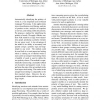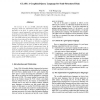1826 search results - page 27 / 366 » Using Random Forests in the Structured Language Model |
ACL
2010
13 years 6 months ago
2010
Automatically identifying the polarity of words is a very important task in Natural Language Processing. It has applications in text classification, text filtering, analysis of pr...
DASFAA
2003
IEEE
14 years 1 months ago
2003
IEEE
The increase in the use of XML (eXtensible Markup Language) makes the semistructured data more and more important on the Web. To exploit the full power of XML documents, a query l...
EUROPAR
2005
Springer
14 years 2 months ago
2005
Springer
Nested-parallelism programming models, where the task graph associated to a computation is series-parallel, present good analysis properties that can be exploited for scheduling, c...
ICMCS
2005
IEEE
14 years 2 months ago
2005
IEEE
This paper considers dynamic language model adaptation for Mandarin broadcast news recognition. Both contemporary newswire texts and in-domain automatic transcripts were exploited...
BMCBI
2010
13 years 8 months ago
2010
Background: Machine learning techniques have shown to improve bacterial species classification based on fatty acid methyl ester (FAME) data. Nonetheless, FAME analysis has a limit...


